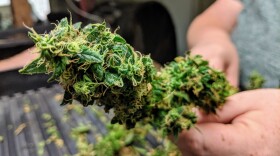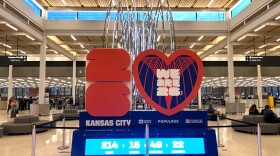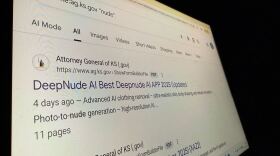Go here to subscribe to the My Fellow Kansans podcast. This season, we look at the prospects of rural places.
GREENSBURG, Kansas — The massive tornado that leveled this town in 2007 pretty much defines disaster.
Eleven people dead. The place in ruins.
Yet without the tragedy, Greensburg wouldn’t have had the chance to transform itself into “the greenest community in America.”
It now runs on renewable energy wired into buildings and homes designed with the latest in conservation technology.
Yet the question persists: What difference did it make?
About 850 people live in Greensburg, still about 600 fewer than when the tornado struck.
“I don’t think that population is the only measurement of success,” said Stacy Barnes, who is Greensburg’s city administrator and now in charge of sustaining the community’s comeback.

Some defensiveness, even spin, lies in the suggestion that the number of people who live in a town doesn’t measure its success. Despite Greensburg’s shinier, more ecological veneer — like so many diminished towns across rural Kansas — it’s less than it wants to be.
Greensburg’s leaders sold the town’s green comeback as a way to set it apart from other withering rural communities. They hoped such a bold plan could help the community buck trends that had been driving people out of rural Kansas for generations.
They’re still hoping.
The tale of Greensburg’s comeback starts on the night after the tornado struck the town. When local, state and federal officials took cover from yet another storm in the basement of the damaged Kiowa County Courthouse.
“The discussion was, ‘Hey, we’re going to build back. Why don’t we do it green?’” said former Mayor Bob Dixson. “The seed was planted that night.”
A dozen years after the devastation, the scars from May 4, 2007, remain visible. Desiccated trees. Vacant lots in the middle of town. A few crumbling foundations where houses once stood.

Still, the town looks fresh and revitalized compared to neighboring communities.
Its new high school brims with technology. Many of the community’s new energy-efficient buildings look like something you’d expect in a trendy tourist town, not in windswept Greensburg.
Great expectations
Barnes, the current city administrator, lived in Lawrence at the time of the tornado. She returned to help her parents — former mayor Dixson and his wife — sort through the rubble of her childhood home. After several trips, Barnes and her husband decided to move back “to be a part of this community’s future.”
First, she worked as an assistant to the city administrator. Then she got a job helping to plan a new museum to showcase the city’s main tourist attraction — a hand-dug well dubbed “the largest” in the nation.
Barnes is back at City Hall now. And she feels pressure to make the community’s comeback story the success envisioned by those who planned it in the months after the tornado.
Drawing a deep breath, she said, “I feel a tremendous responsibility.”

“Early on,” she said, “there were probably some unrealistic expectations.”
The town’s effort to transform itself captured international attention. Actor and environmental activist Leonardo DiCaprio produced a Discovery Channel television series about it. Reporters arrived from around the world to tell a story of a community’s phoenix-like rebirth.
The town built a 72-acre business park for the green companies that indicated to Dixson that they wanted to be a part of Greensburg’s celebrated transformation.
“We were under the impression that there would be opportunities,” Dixson said. “But it just never panned out.”
Today, the business park sits empty at the edge of town. To some, it’s evidence of the community’s failure to fully capitalize on its green rebirth. Yet Barnes insists the park still represents “opportunity.”
“We continue to work on projects,” she said.
Among other obstacles, even the remade version of Greensburg doesn’t have enough affordable housing.

Dennis McKinney, a former state treasurer and one-time legislator from Greensburg, said housing shortages hold back communities across rural Kansas.
“I’ve talked to community leader after community leader from all over Kansas,” he said. “That’s their number one issue.”
Promises and realities
Scott Brown played a key role in Greensburg’s recovery. The building that houses his auction and real estate company on the east edge of town was just outside the path of the tornado. People gathered there to talk about whether they intended to stay and rebuild.
At one of those early meetings, Brown said, 63 people who had owned businesses in town signaled their desire to rebuild.
That may not sound like a big number, Brown said, “but I didn’t even know there (were) 63 businesses in Greensburg before the tornado.”
Early on, developers from Wichita, Kansas City and Denver offered to help rebuild the downtown business district. They walked away, Brown said, when it became clear that they couldn’t charge enough rent to make any money.
“That’s what spurred me into action, I guess,” he said.

Brown figured it would cost about $1 million to build a kind of strip mall in what used to be downtown. He concluded that money needed to come from residents “not interested in getting a financial return.”
Those people invested, Brown said, just to support “a place to get a hamburger (or) get their hair fixed.”
Pitching in
Brown put up the first $50,000 and asked others to give what they could. Some matched his contribution. Others gave $10,000 or $5,000 to fund the Kiowa County United Foundation.
When it opened in 2009, the downtown mall was fully paid for and fully occupied. Over the past decade, Brown said, occupancy has averaged between 80% and 90%.
Brown would like to think that all the community has accomplished over the last 12 years has made it less vulnerable to the economic and cultural forces threatening the survival of rural communities across Kansas and the Plains.
He hopes it isn’t destined to become a “ghost town with the newest buildings.”
“I don’t doubt that we’ll survive, but that’s not what we want to do,” he said. “We want to get a little growth.”
This is the fifth in a series of stories investigating the decline in rural Kansas and efforts to reverse it.
Support for this season of “My Fellow Kansans” was provided by the United Methodist Health Ministry Fund, working to improve the health and wholeness of Kansans since 1986 through funding innovative ideas and sparking conversations in the health community. Learn more at healthfund.org.
Jim McLean is the senior correspondent for the Kansas News Service, a collaboration of KCUR, Kansas Public Radio, KMUW and High Plains Public Radio covering health, education and politics. You can reach him on Twitter @jmcleanks or email jim (at) kcur (dot) org.
Kansas News Service stories and photos may be republished by news media at no cost with proper attribution and a link to ksnewsservice.org.
Copyright 2019 KCUR 89.3








